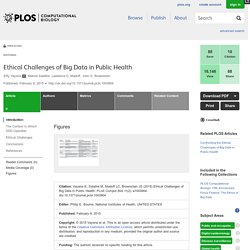

Ethical Challenges of Big Data in Public Health. Citation: Vayena E, Salathé M, Madoff LC, Brownstein JS (2015) Ethical Challenges of Big Data in Public Health.

PLoS Comput Biol 11(2): e1003904. doi:10.1371/journal.pcbi.1003904 Editor: Philip E. Bourne, National Institutes of Health, UNITED STATES Published: February 9, 2015 Copyright: © 2015 Vayena et al. Funding: The authors received no specific funding for this article. Competing interests: The authors have declared that no competing interests exist. Introduction Digital epidemiology, also referred to as digital disease detection (DDD), is motivated by the same objectives as traditional epidemiology. This is a nascent field that is developing rapidly [10]. The Context in Which DDD Operates DDD operates at the intersection of personal information, public health, and information technologies, and increasingly within the so-called big data environment. SIWP 2014 009 The Role of Big Data in Governance FINAL. Adult gang members and their children’s contact with Ministry of Social Development service lines - Ministry of Social Development.
The harm inflicted by gangs is a serious issue in New Zealand.

We have a complex gang problem that spans social, economic and justice issues. Almost half of the serious offences committed by gang members are family violence-related. A high proportion of gang members’ children experience multiple incidents of abuse or neglect. Adult gang members and their children’s contact with Ministry of Social Development service lines seeks to quantify the scope and scale of the societal impact of adult gangs in New Zealand as it relates to contact with the Ministry. The report establishes baseline figures on how many known adult gang members, and how many of their children, come into contact with the Ministry of Social Development’s service arms, and the types and estimated total costs of contacts that occur.
This report, as a first step, gives a much more comprehensive picture of the social costs associated with gang members. 2053951714563194. 2053951714541861. The NSA’s SKYNET program may be killing thousands of innocent people. In 2014, the former director of both the CIA and NSA proclaimed that "we kill people based on metadata.

" Now, a new examination of previously published Snowden documents suggests that many of those people may have been innocent. Last year, The Intercept published documents detailing the NSA's SKYNET programme. According to the documents, SKYNET engages in mass surveillance of Pakistan's mobile phone network, and then uses a machine learning algorithm on the cellular network metadata of 55 million people to try and rate each person's likelihood of being a terrorist. Patrick Ball—a data scientist and the director of research at the Human Rights Data Analysis Group—who has previously given expert testimony before war crimes tribunals, described the NSA's methods as "ridiculously optimistic" and "completely bullshit. " A flaw in how the NSA trains SKYNET's machine learning algorithm to analyse cellular metadata, Ball told Ars, makes the results scientifically unsound. International Data Privacy Law 2013 Rubinstein 74 87.
China is building a big data platform for “precrime” It's "precrime" meets "thoughtcrime.

" China is using its substantial surveillance apparatus as the basis for a "unified information environment" that will allow authorities to profile individual citizens based upon their online behaviors, financial transactions, where they go, and who they see. The authorities are watching for deviations from the norm that might indicate someone is involved in suspicious activity. And they're doing it with a hand from technology pioneered in the US. As Defense One's Patrick Tucker reports, the Chinese government is leveraging "predictive policing" capabilities that have been used by US law enforcement, and it has funded research into machine learning and other artificial intelligence technologies to identify human faces in surveillance video.
The Chinese government has plenty of data to feed into such systems. International Data Privacy Law 2012 Kuner 47 9. What is big data? Big data is data that exceeds the processing capacity of conventional database systems.

The data is too big, moves too fast, or doesn’t fit the strictures of your database architectures. To gain value from this data, you must choose an alternative way to process it. The hot IT buzzword of 2012, big data has become viable as cost-effective approaches have emerged to tame the volume, velocity and variability of massive data. Within this data lie valuable patterns and information, previously hidden because of the amount of work required to extract them. To leading corporations, such as Walmart or Google, this power has been in reach for some time, but at fantastic cost. The value of big data to an organization falls into two categories: analytical use, and enabling new products.
The past decade’s successful web startups are prime examples of big data used as an enabler of new products and services. What does big data look like? Volume Velocity Why is that so? Variety In practice.